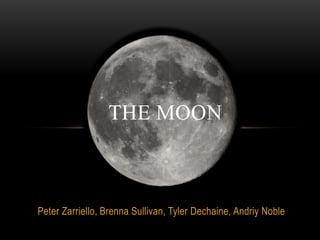
The moon
- 1. The Moon Peter Zarriello, Brenna Sullivan, Tyler Dechaine, Andriy Noble
- 2. HYPOTHESIS of how the moon was formed The condensation hypothesis suggest the moon was formed in a cloud of gas and debris just like the planets The capture hypothesis suggests the moon was an asteroid that was captured by the earths gravitational mass The fission hypothesis states the moon broke off as a chunk of the earth while the planet was spinning fiercely The large impact hypothesis states that a mass the size of mars crashed into earth nearly destroying the planet and sending a massive cloud of debris into orbit. this debris over time came together to form what is now known as our moon.
- 3. The beginning of the moon When the moon was created 3.8-4.5 billion years ago, it was pummeled with asteroids and the low areas filled with oozing molten lava Over a period of 750 million years the molten lava cooled to form areas that are black like ash known as the maria.
- 4. Craters and Maria on the moon The moon is littered with craters and large low lying flat lands.
- 5. The Highlands the cratered areas are called the highlands and the dark low areas are called the maria.
- 6. Geology of the moon The dark gray areas of the moon that we see from earth are known as the lunar lowlands. The lighter colored mountains are known as the lunar highlands. The moon looks bright against the stars in the night sky, but it only reflects 6 percent of the light that hits it. The craters on the moon were created by impacts. Most were created when the solar system was young. The hilly regions of the moon are covered with a rock called anorthosite. This rock is a light colored rock which is made up of calcium and aluminum.
- 7. The Motions of the Moon The moon moves eastward in the sky, toward the background stars. Each night if you were to watch the moon, its about 13 degrees east from the spot it was the night before. The moon takes about one month to completely orbit around the earth.
- 8. Moon Phases The moon always keeps the same side facing the earth, and you never see the far side. Sun illuminating on different parts of the side of the moon produces the different phases of the moon. The orbital period of the moon around the earth is not the same as the length of a moon phase cycle. The phases of the moon are New Moon, Waxing Crescent, First Quarter, Waxing Gibbous, Full Moon, Waning Gibbous, Third Quarter Moon, and Waning Crescent.
- 9. Faces of the moon Near-Side Far-Side
- 10. Phases of the moon
- 11. Your Weight on the moon The moon is 1/4 the size of Earth, so the moon's gravity is much less than the earth's gravity, 83.3% less. If you weigh 150lbs on Earth you would only weigh 24.9lbs on the moon. Or 1/6th of your weight of that on the Earth.
- 12. Gravity field of the moon The gravitational acceleration on the surface of the moon is 1.63 m/s2 or about 16.7% that on Earth's surface. The major characteristic of the Moon's gravitational field is the presence of mascons, which are large positive gravity anomalies associated with some of the giant impact basins.
- 14. Landing on the moon
- 15. Life On The Moon No life currently exists on the moon that we know of, and no life used to exist that we know of Water is the basis of life that we know and the moon lacks the abundant amount needed to support life In 2009 water on the moon was found in such small increments that the earths driest deserts have more water In 2010 an estimated 600 million tones of frozen layers meters thick of ice were found in the north pole of the moon
